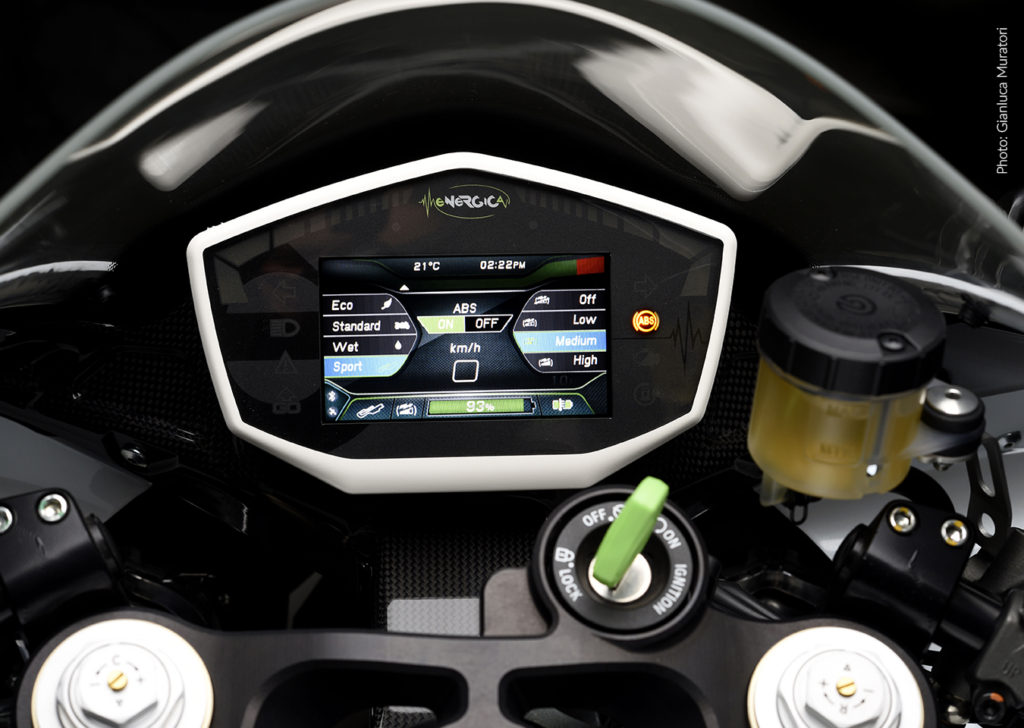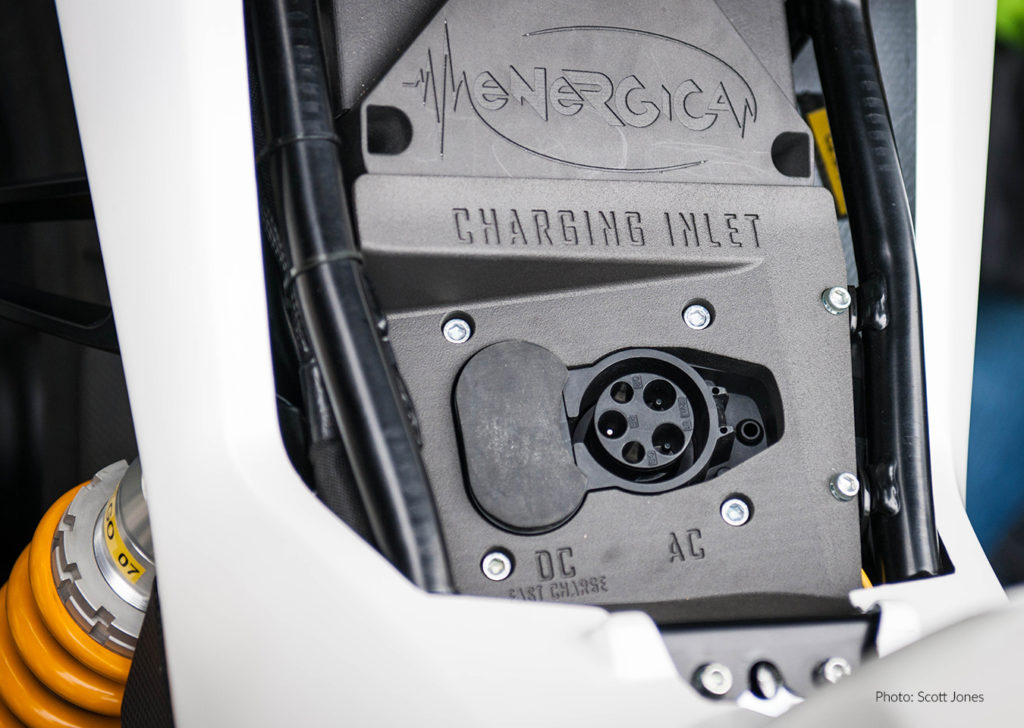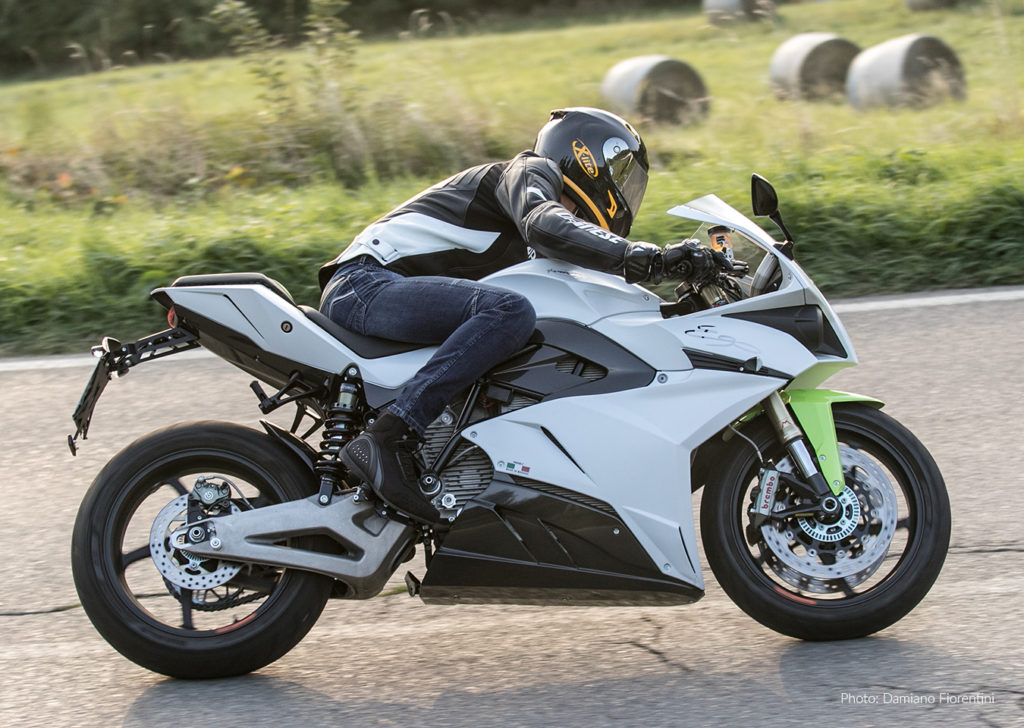While electric transport is slowly gaining traction for commuting and short city traffic, range and charging times remain major obstacles for most other journey types. But these obstacles could become a distant memory with the rapid development of better batteries. The 100% electric and sportive Energica Ego is equipped with a fast-charge capacity. I recently spent a few days driving around the Netherlands on an Energica Ego enjoying the benefits of the recently installed fast-charge network along Dutch motorways. The fast-charge network is currently being rolled out across the rest of Europe.

The machine
As you would expect from CRP, the Italian high-tech group, the Energica Ego is constructed from quality components. At the front there’s an adjustable Marzocchi fork and Brembo monoblocks with Bosch ABS. And at the back there’s an aluminium swing arm cushioned with a Bitubo adjustable monoshock suspension. The chassis is constructed around a lattice tube frame.
The Ego uses a brushless, synchronous, oil-cooled engine with permanent magnets to deliver 100 kW (136 hp) and 195 Nm torque in sports mode. This power is transmitted via an O-ring chain to the real wheel. The top speed is limited to 240 km/h which is more than enough for normal riding. And to help with the riding range, energy is returned to the battery via regeneration during engine braking.
Loading the 11.7 kWh lithium polymer energy package is straightforward at a charging station or a socket with the on-board 110-220 volt charger. The loading speed can be set from 6 to 13 Amps, taking the battery from empty to full in 10 to 2.5 hours (respectively). Fast charging is possible thanks to the direct current Combo connector located under the seat. This charges the battery from 0 to 85 % in 20-25 minutes. In Eco mode, the Ego has a range of 200 km (up to 90 km/h).


The drive
The Energica Ego rides like a sporty Italian bike, leaning on your wrists with your feet high in the footrests – and with enough room to change positions. It’s a smooth ride. A twist to the throttle and the engine ‘roars’. A gearbox isn’t necessary thanks to the ever-present torque. And all the information you need is easily accessible on the TFT colour display on the handlebars.
I was surprised by the Ego’s power and how it changes depending on the selected mode – Sports, Urban, Eco or Rain. To begin with, I closely watched my available range, but I soon gave into temptation and hit the ‘gas’. The extra power this consumed was offset by even driving and battery regeneration, especially in towns.
There are four regeneration positions, ranging from braking like a two-stroke engine to a thick four-stroke engine. Regeneration can also be turned off. The brakes handle the bike’s 268 kg weight with ease. In practice, I found I hardly needed the Brembo breaks, because of using the regenerative breaks.
Steering in tight corners is easier than I expected thanks to the instant torque and the absence of a rapidly rotating mass in the engine. In fact, long continuous curves and acceleration are also smooth. However, I did feel the bike’s weight when braking hard or moving slowly. The bike’s impressive acceleration misses the familiar engine noises that you expect, meaning I often found myself driving faster than I expected. The Ego’s manoeuvrability is simple with the Park Assist that includes a reverse function, limited to 2.8 km/h.


When riding on motorways, I kept to an even speed and found that I still had 20-30% power when I charged every 80-100km. Fast charging to 85-95 % power took 20-25 minutes. By keeping the battery level to over 19 %, I avoided the ‘limb’ mode that limits the top speed to 90 km/h.
And what about the cost?
With a subscription, 1 kWh fast charging costs 19 cents. A full 11.7 kWh charge costs € 2.22. I paid between € 1.50 and € 2.00 per charge during the test ride. Fast charging is paid immediately via an app or an RFID card, depending on the provider. Fully charging the battery at home costs 21 cent per kWh. It isn’t necessary to completely empty or fill the battery each time, but it is recommended to fully charge the battery and ‘balance’ it regularly. Balancing the battery happens during the last 5% of the charge and takes relatively more time, but can be easily done by charging the bike overnight at home. The electric motor and battery don’t require maintenance.


Conclusion
The Energica Ego is a beautifully finished motorcycle, equipped with high-end components with sporty handling and driving position. The dashboard provides a lot of information and Bluetooth and UMTS communication is possible with a smartphone application, tablet or laptop. For charging at a charging station or away from home, you’ll need a charging cable. Fast charging is also possible in the Netherlands, but not (yet) in the surrounding countries, limiting the user area for the time being.
The Ego starts at € 31,858.00 (including VAT), which is a bit costly for the average consumer. However, there are currently tax benefits for companies that total approximately a third of the Ego’s purchase price.
Specifications (1)
Maximum speed
Limited at 240 km/h
Range
190 km @ 60 km/h
150 km @ 80 km/h
100 km @ 100 km/h
Driving modes
– Eco
– Standard
– Rain
– Sport
Park Assist
Reverse (max. 2.8 km/h)
Forwards (max. 2.8 km/h)
Engine
Permanent magnet AC (PMAC)
Peak torque: 195 Nm
Peak power: 100 Kw (ca 136 hp)
Battery
11.7 kWh lithium-polymeer
Minimum 80% capacity after 1,200 charging cycles
Charging times
20 – 30 Mode 4 (fast charge)
+/- 2 hours from 20 to 80%
3.5 hours from 0 to 99% SOC
Charging options
– Home
– Charging station
– Fast charging
Dimensions
Seat height: 810 mm
Wheelbase: 1,465 mm
Length: 2,140 mm
Height: 1,140 mm
Width: 720 mm
Recent update:
Ego: 106.4 kW (145 hp) and 200 Nm
(1) This data sheet is provided for reference only. Energica Motor Company reserves the right to substitute or change components.
Author: Andrew Thijssen for Electric Motorcycles News
More info & full specifications: Energica Motor >